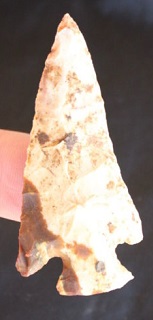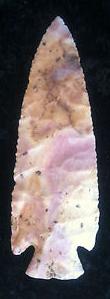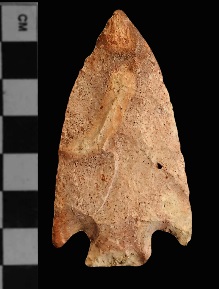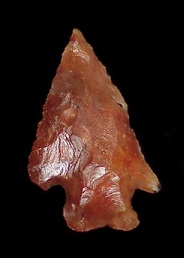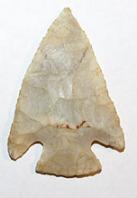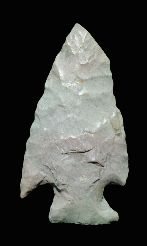Name Details:
Named By: Ripley P. Bullen
Named For: LaFayette County, Florida
Date Identified: 1968
Type Site:
LaFayette
Cluster:
Commonly Utilized Material:
Coastal plains chert
Date:
Cultural Period:
4,000 - 3,000 B.P.
Late Archaic
Neoglacial
Glacial Period:
Culture:
Outline is Representative of Size and Shape:
Description of Physical Characteristics and Flaking Pattern:
This is a broad medium to
large (1.5 to 4 inches)
triangular corner notch point with a elliptical cross section towards the tip becoming more flattened towards the base. The blade is excurvate with many examples curving in at the tip and
curving back in or rounded at the shoulders. The blade is never
beveled or serrated. U-shaped notches enter the blade diagonally from the corners of the preform forming strongly barbed shoulders with the barb terminations
varying from pointed to rounded. Re-sharpened examples may have reduced shoulders. The stem is primarily expanding, but
may vary to slightly expanding. The base ranges from slightly convex to straight. Basal thinning is commonly seen,
but basal / hafting grinding is never present. This point has a random flaking pattern.
Size Measurements: Total Length -
28 to 100 mm (average 40 to 70 mm), Stem Length - 8 to 14 mm,
Blade Width - 22 to 47 mm (average 30 to 35 mm), Neck Width - 11
to 22 mm, Stem Basal Width - 14 to 30 mm, Thickness - 6 to
11 mm (*** see additional comments)
Distribution:
Distribution Comments:
This point is primarily found from southern Georgia, through-out Florida, and into southeastern Alabama.
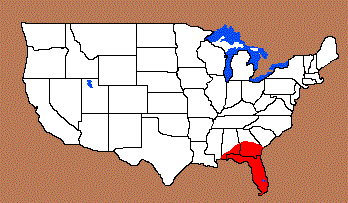
Related / Associated Points:
Additional Comments:
It has been suggested that the Clay point may be a variant of the LaFayette point. They are similar, except where the Clay point has angular or squared barb terminations, the
LaFayette point has pointed or rounded barb terminations (Granger and Granger, 2013).
Farr (2006) included both types into a single type referring to these points
as Clay/Lafayette.
*** Whaley (2002) noted that noted that a site from Warren County
produced what he referred to as Small Lafayette point with the length 28 to
32 mm averaging 30 mm. The averages fro these points were not included
in the average of standard Lafayette points.
Please see link below for more examples of this point type.
Other points in this Cluster:
Point Validity: Valid Type
Bullen was a distinguished
anthropologist and Curator Emeritus of the Florida Museum of Natural History. He was dedicated to identifying and typing projectile points from Florida. This point was named in a professional publication and is professionally a widely recognized type. This is a valid type.
.
Age Details:
Milanich (1994) states that Lafayette points in the Tampa Bay area were more
commonly used around 2,500 B.P. and later Estimated time range for
Lafayette points would be 3,400 to 2,400 B.P.
References: (See Reference Page, Entry Number):
23, 30, 58, 59, 162, 167, W18
Lafayette Projectile Point, Lafayette Arrowhead
